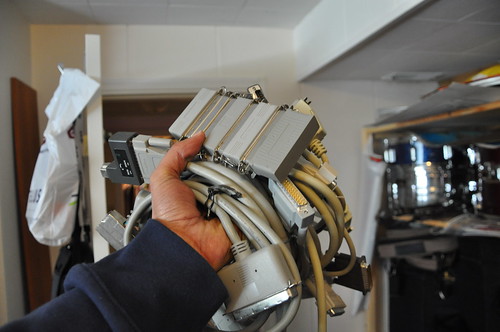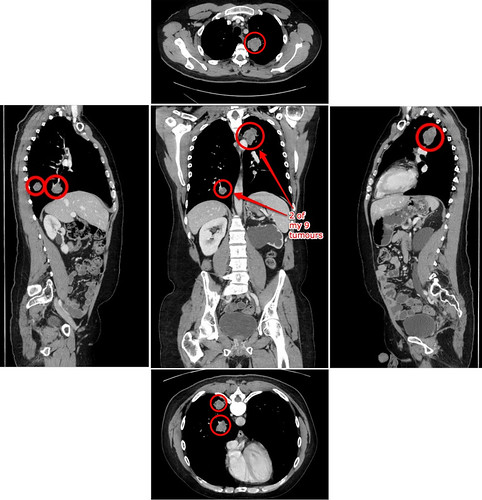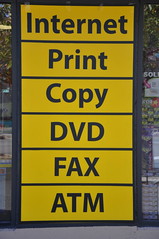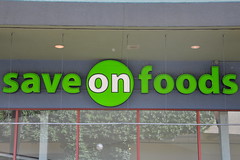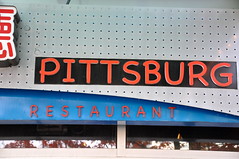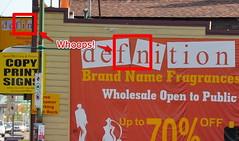Penmachine
25 April 2010
A brief visit to the 2010 Vancouver Camera Show
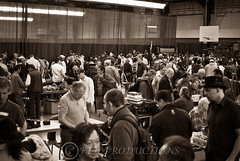 Today was the 2010 Vancouver Camera Show, held by the Western Canada Photographic Historical Association at the Cameron Rec Centre in Burnaby, near Lougheed Mall. I wasn't planning to go, but it turned out that my daughter Marina's new lenses for her glasses, which we got yesterday, were flawed, and needed to be replaced by the optician at that mall, so the two of us were in the area and had some time to kill.
Today was the 2010 Vancouver Camera Show, held by the Western Canada Photographic Historical Association at the Cameron Rec Centre in Burnaby, near Lougheed Mall. I wasn't planning to go, but it turned out that my daughter Marina's new lenses for her glasses, which we got yesterday, were flawed, and needed to be replaced by the optician at that mall, so the two of us were in the area and had some time to kill.
Marina was enthusiastic—she was interested in looking at old Polaroid cameras and to see what the event was like. We walked from the mall, and I paid my $5 admission. (Marina was free.) And wow, it's a heck of an event.
The rec centre gym was filled with dozens of tables with thousands of items of photographic and movie equipment, most of it of some vintage, like the Nikon FE I bought the other day (or a bit newer, or a lot older). Cameras, lenses, flashes, tripods, bellows, enlargers, filters, parts—a photo geek's dream.
It was still very busy, even though we were there barely an hour before closing time. The crowd skews heavily male, and older, but Marina and I had fun poking around at the various obscurities, most in black and chrome, or maybe even leather. I didn't bring much money, nor did we buy anything, yet we hardly noticed the time pass before her glasses were ready and we had to leave. I didn't even take any pictures!
I'll plan to attend again next year, if I'm healthy, and to go earlier. Both Marina and her sister might like to come along, if their photographic interest persists until 2011. Honestly, if I'd gone myself, I probably could have browsed all day. But like a gambler, I'd have to bring cash in advance and set myself a hard limit.
Labels: conferences, family, geekery, meetup, photography, vancouver
23 April 2010
Geek office cleanout redux
Almost five years ago, I cleaned out a bunch of old electronics and cardboard from my office/studio downstairs. Yesterday, Earth Day, I got started on it again, this time shipping out four old CRT monitors, two printers, two desktop Macs, an old PowerBook, a couple of keyboards, a scanner, an external CD-ROM drive, a broken camcorder, and a whole mess of wires:
I had an incentive to do it today because, on her way to work, my wife Air noticed a one-day Earth Day electronics recycling event at Killarney Secondary School, which is where I took the heap. It was gone in less than five minutes.
My happiest discard was a drawer full of particularly beige SCSI cables, adapters, and terminators. If you've grown up connecting things to computers with USB or FireWire or Ethernet cables, or using Wi-Fi, be thankful you didn't have to deal with SCSI and its predecessors, which often required flipping tiny switches, swapping cables around, adding thick cable terminators to devices in apparently random combinations, and fiddling with software—and still often didn't work right. Good riddance, SCSI cables:
I felt like Perseus with the head of Medusa there. And yes, I reformatted my hard disks before donating them.
Labels: apple, geekery, green, home, memories, school
21 April 2010
Back to 1978
A couple of years ago, I bought an old Nikon F4 film camera (introduced in 1988), and I've enjoyed taking pictures with it, especially in black and white. It's a pretty big beast, though, and over time I've been thinking about the first camera I bought for myself in the early '80s, a manual-focus Nikon FG. Then I spotted a surprisingly cheap deal on eBay, and this week it arrived:
It's a Nikon FE, a slightly older (introduced in 1978) and slightly higher-end model than my FG, and it came with a manual-focus 50 mm Nikkor lens. For many years, the electromechanical FE, its companion mechanical FM, and their successors the FE2 and FM2 were often the backup camera bodies of choice for professional photographers—less expensive than the top-of-the-line F2, F3, or F4, but still rugged and simple to use.
Like my F4, this thing feels like a brick, because unlike the digital cameras most people buy today, the FE is almost all metal, including the lens housing. It's also surprisingly small, since it lacks the rubberized covering and big handgrips that digital SLRs like my D90 have. (Since film is out of fashion, the FE also cost me a tiny fraction of the price of the D90.)
Besides my general Gear Acquisition Syndrome and the dirt-cheap price, another reason I bought the FE is that my younger daughter L has been wanting to learn a bit more about photography, and the principles are much easier to demonstrate on an old film camera. With a fixed (non-zoom) lens on it, there are really only three things to adjust: aperture, shutter speed, and focus. DSLRs let you change ISO (sensitivity) and white balance too—among many, many other features—but with the FE those are determined by the film you choose.
I've loaded the FE with some 400-speed black-and-white film, and we'll see how the first photos turn out, and how the photographic experience compares to the F4 and D90. A nice feature of film cameras (despite the inconveniences) is that, whenever you buy new film, you're effectively putting a new sensor inside, so they don't really become obsolete the way digital cameras do.
Labels: cameraworks, family, geekery, nikon, photography
14 April 2010
Movable Type vs. WordPress, Round 2
A bit more blogging platform geekiness, but much shorter this time.
Contrary to my first impressions a couple of days ago, I'm warming to the way Movable Type works. It's taken only a little effort to customize it, roughly to match my existing page design and typography here—easier than I've experienced with WordPress.
So, two days later, it looks light I might end up using Movable Type 5 after all. But we'll see if my further experiments blow it up in some nasty way.
Labels: blog, geekery, linkbait, software, web, writing
12 April 2010
Replacing Blogger: Movable Type vs. WordPress
This is a big long nerd brain dump about behind-the scenes software stuff on this website. Even if you're not a web geek, there's a possibility you might find some of it interesting. But if not, you've been warned.
UPDATE: A couple of days later, I may have changed my mind about my apparent decision below. Find out more.
Gotta move
Since Blogger announced the shutdown of its venerable FTP publishing system a couple of months ago, I've been working to figure out what new system I'm going to use to publish my writing here. (I'm glad Blogger postponed the shutdown for an extra month, but of course that meant I simply procrastinated about it until now.)
I have about three weeks to make the change, and I've boiled it down to two options, neither of which is ideal, but both of which are serviceable:
- WordPress (currently at version 2.92), a PHP-based system, with the Really Static plugin.
- Movable Type, written largely in the Perl programming language (currently at version 5.01).
They are two of the most popular and long-running blogging platforms on the Web. There are other possibilities, but I don't need all the complexity of Drupal, and don't find other options like ExpressionEngine all that compelling. Movable Type has always used the static files publishing model I prefer, while WordPress requires a plugin like Really Static to hack it into doing what I want.
Movable Type in the sunset?
However, Movable Type's day in the sun may be past. While some high-profile sites of people I know—such as John Gruber and Dave Shea—use it, its popularity seems to have been in general decline since the licensing controversies of version 3, way back in 2004. The current version 5 (MT5) is brand new, and an open source project, but I don't sense the same community vibrancy and wealth of third-party extensions WordPress has. Six Apart, the company that created Movable Type, also seems to have been focused on its other hosted blogging tools, TypePad and Vox, for years.
There's a fork of Movable Type called Melody too, which is cool. But forks like that tend to arise when the originating platform is losing air. Yes, I know there are lots of people who love it, but I just get the sense that general enthusiasm for Movable Type has faded—even in the vibe I feel after installing and playing around with MT5 last night. The basic software is great, mature, and solid. But when I want to muck around and extend it, the available resources are a little sparse and often out of date.
WordPress on a tear
Just when Movable Type stumbled in 2004, Matt Mullenweg's WordPress—itself a fork of the awkwardly-named b2/cafelog blogging platform—was hitting its stride. I know Matt a bit, and have been using WordPress on other websites (most notably Inside Home Recording and Lip Gloss and Laptops) since 2006. I like it and recommend it to friends, despite its sometimes-sprawling nature, and its reliance on a dynamic, on-the-fly, database-driven publishing approach that I find somewhat brittle.
Indeed, that dynamic approach really was the only thing keeping me from switching to WordPress right away. I understand WordPress and how to tweak it, I like the wide range of themes and plugins available for it, most of my geek friends use it in some form or another, and the community is second to none. Recent versions are also very easy to upgrade in place, which is a big improvement over the way most installable blog platforms (WordPress and Movable Type included) have usually worked.
So when Matt Mullenweg's colleague, Victoria-based Lloyd Budd, pointed out the Really Static plugin to me, it looked like a perfect solution. It takes a regular WordPress blog and generates plain-old text files which otherwise continue to look and work pretty much just like the original WordPress pages. Nice.
The showdown
Therefore, last night, after all that procrastinating and evaluating, I installed both WordPress 2.9.2 (with Really Static) and Movable Type 5.01 into test directories on my server. The WordPress install went smoothly, since I've done it before. Movable Type took a couple of tries, but I got it working without too much trouble. Disabling either software installation seems to leave the resulting static blog pages essentially intact, which, after all, is my key criterion in this whole production.
As I said above, I found Movable Type underwhelming. I really, really wanted to like it, because it would be interesting for me to learn how to work with and tweak a new publishing system. The default appearance theme is certainly nicer than WordPress's, and its more modular system of templates and styles is also a bit more elegant. Though not a key feature for me, it's much easier to publish multiple blogs with a single Movable Type installation (at least for now). Some tech-head friends I respect a lot think its Perl-based CGI architecture is inherently better than WordPress's collage of PHP scripts.
All that may be true, but MT5 looks, to me, like it's catching up to features and polish that WordPress has offered for at least two or three years. Searching for some alternative themes and styles, as well as fairly simple plugins (displaying my recent Twitter posts on my home page, for instance), didn't yield very many options, and most of the results I did get seemed to be talking about MT installs a version or two old.
Not that the WordPress option is perfect. The forest of PHP files that WP uses can make heavy customizing kind of a chore ("which of those 250 files was I supposed to edit again?"). The Really Static plugin remains a hack, though an effective one, so making it do what I want requires some duplication of template files, some advance planning of how I want to structure my blog and archives, careful pruning of HTML pages on the server if I choose to delete something, and the awareness that when WordPress releases a new version (like the upcoming 3.0, or even a service update like 2.9.3), I might have to wait to make sure Really Static plays nice with it.
So right now, I'm leaning heavily toward the WordPress/Really Static approach [but wait! see my April 14 post to find out if I changed my mind]. Any Movable Type advocates (or people with different suggestions) who want to convince me otherwise can email me or leave a comment here—at least until I disable comments on this post at the end of the month (see below).
Other housekeeping
One annoying thing about moving away from Blogger as my publishing system is that I'm going to have to lock down my blog archives. What I mean is, I'm not planning to import all my nearly 10 years of existing blog posts into the new system and republish them. Indeed, one of the advantages of the static-files approach I'm choosing is that I can just leave my old posts exactly as they are, whether from 2001 or 2009.
But since I'll no longer be able to update the pages from Blogger, that also means that no one will be able to post new comments to those posts—or, more accurately, if I leave things as they are, people can write comments, but they'll never show up on this website. So my plan, over the course of the next three weeks, is to disable new comments on my old posts, and gradually disable them on newer and newer ones until FTP publishing stops working at the end of the month. Then, if I time things right, I can seal off comments on my latest entries, tie up the old blog in a bow, fire up the by-then-ready new system, and be done.
I've already started. Want to comment on one of my posts from April 2007 or earlier? Sorry, you can't. Same for entries for my occasional Penmachine Podcast from last year or before. They were never much for comments either.
Yeah, it's a bit of an awkward transition, but after a decade of largely smooth sailing with Blogger, I can hardly expect anything else. I'll miss the simplicity and familiar orange-and-blue colour scheme of writing in Blogger, but I won't miss its bizarre system of labels, its strange way of handling podcast enclosures, and of course the consistent unreliability of FTP publishing in the first place. Besides, for the geek in me, making the change is sort of fun.
As long as I don't screw anything up too badly over the next few weeks, anyway.
Labels: blog, geekery, linkbait, software, web, writing
07 April 2010
My first microwave experience
The first time I ever used a microwave oven was at my friend Brent Spencer's house, sometime in the mid-1970s. I'm pretty sure it was an Amana Radarange. Brent's father Ken, who would later go on to found the digital printing company Creo, is an engineer, and often had interesting gadgets well before the rest of us got them.
(Some examples: Ken borrowed a projection television for a few weeks, which I got to watch in their basement; was the first person I knew to have a phone in his car; and loaned us their family's TRS-80 microcomputer while they went on a long vacation in 1980.)
Anyway, the first thing Brent showed me how to make in the exotic Radarange was Triscuits with Kraft process cheese slices melted on top. I stared in wonder through the oven window as the cheese rose into what seemed like an impossibly big bubble, then popped into a goopy mess. Delicious.
Recently I did the same thing: 30 seconds on high power, with Triscuits and Kraft slices. You know what? They still tasted great.
Labels: age, food, friends, geekery, memories
23 March 2010
Another party movie
Reilly made a movie of the party we went to on the weekend:
You might recall another one of his videos I posted a couple of weeks ago.
Labels: birth, friends, geekery, movie, party, photography, vancouver, video
17 March 2010
The Nikon FM3A
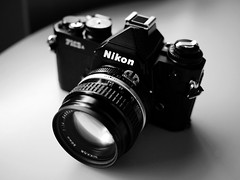 Camera nerds have strange obsessions. Among film cameras, the Leica M series of small rangefinder devices is probably top among photo fetishists, who might argue about whether the original 1950s M3 or the current M7 or MP is the optimum design.
Camera nerds have strange obsessions. Among film cameras, the Leica M series of small rangefinder devices is probably top among photo fetishists, who might argue about whether the original 1950s M3 or the current M7 or MP is the optimum design.
But to me, the manual-focus, precision-built electromechanical Nikon FM3A SLR is the real star of these old-school cameras. It was an oddity when Nikon introduced it in 2001—by which time ergonomically-shaped, plastic-bodied autofocus cameras were what almost everyone used, and digital was poised to take over from film almost entirely. (Even the FA of 1983, or the intro-level FG I owned around the same time, had more modern features in many respects.)
But Nikon was intentionally building a modernized retro camera for those fetishists. It offers basic but powerful light-metering, manual focus assistance, fill-flash compatibility, and aperture-priority automation if you want it. But it is also a fully-mechanical machine that will operate perfectly (except for the light meter) without any batteries. All the power to run it can come from energy stored in springs when you ratchet the film advance lever with your thumb, something that's hard to comprehend for anyone who's used to today's battery-sucking digital beasts, or even my 1988 autofocus Nikon F4.
Nikon only made the FM3A for five years, and manufactures nothing at all like it today. (Indeed, almost no one besides Leica makes fully mechanical cameras anymore.) If you can find one, it sells for pretty close to the $800 the model fetched when new, which is still a fraction the cost of a Leica or a top-of-the-line digital Nikon SLR. And it will use most Nikon-mount lenses made between 1977 and quite recently, when the company stopped including aperture rings on their SLR lenses.
I'd compare this rugged Nikon with modern versions of the Fender Stratocaster guitar, or a brand-new fountain pen: the FM3A looks superficially like something created decades earlier, and works pretty much that way too, but it has some clever modern enhancements that smooth the way for enthusiasts or professionals to use it elegantly. It's neat that Nikon ever decided to create it, and like the still-manufactured Nikon F6 film SLR, it's probably among the last of its kind.
Labels: film, geekery, history, nikon, photography
14 March 2010
The privacy transition
 A few weeks ago, my daughter Marina, who's 12, asked me to start mentioning her by name on this website, and when I link to her blog, photos of her on Flickr, the new blog she just set up with her sister, and so on.
A few weeks ago, my daughter Marina, who's 12, asked me to start mentioning her by name on this website, and when I link to her blog, photos of her on Flickr, the new blog she just set up with her sister, and so on.
Until now, I've been pretty careful about just calling her "M" or "Miss M," because while I'm personally comfortable putting my own name and information on the Web, that's not a decision I should have been making for my kids, especially before they were able to understand what its implications are. (For similar reasons, here on the blog I generally refer to my wife by her nickname Air, at her request.)
But Marina has started to find that annoying, because when she searches for "Marina Miller," she nearly always finds other people instead. She's starting to build herself an online profile—and the first component of that is establishing her online existence.
I was online around that age too, but at the turn of the 1980s it was a very different thing. In fact, no one expected to be themselves: we all used pseudonyms, like CB radio handles. And it was a much smaller, geekier community—or rather, communities. I had no Internet access until the decade was over, so connections were local, and each bulletin board system (BBS) was its own island, accessed by dialup modem, often by one person at a time. The Web hadn't been invented, and the concept of a search engine or a perpetual index of my online life was incomprehensible.
On a recent episode of CBC Radio's "Spark," Danah Boyd, who researches these things, noted that today's adults often look at our online exposure in terms of what can go wrong, while our younger compatriots and children look at it in terms of its benefits, or what can go right. It's not that they don't care about privacy, but that they understand it differently.
Marina is now closer to adulthood than toddlerhood, and her younger sister, at 10, is not far behind. I think that's a bit hard for any parent to accept, but in the next few years both our daughters have to (and will want to) learn to negotiate the world, online and offline, on their own terms. Overprotective helicopter parenting is a temptation—or today, even an expectation—but it's counterproductive. Just like we all need to learn to walk to school by ourselves, we all need to learn how to live our lives and assess risks eventually. I'd rather not wait until my kids are 18 or 19 and only then let them sink or swim on their own.
I think I share the more optimistic view about being myself on the Web because, unlike many people over 40 today, I have been online since even before my teens, and I've seen both the benefits and the risks of being public there. I hope my experience can help Marina and her sister L (who hasn't yet asked me to go beyond her initial) negotiate that landscape in the next few years.
That is, if they continue to want my help!
Labels: blog, controversy, family, geekery, probability, web
06 March 2010
Movie from still frames
Our friends Miranda and Reilly had going-away party last night for Tanya, who's moving to Calgary with her fiancé Barry. Reilly made a video:
Interestingly, he used a digital still camera. Not even the movie mode on a still camera, but the super-high-speed burst shooting mode of his top-of-the-line Canon EOS-1D Mark IV digital SLR, which can fire away at up to 10 frames per second. (Miranda and Reilly are the kind of people who are supposed to have expensive cameras. They're wedding photographers, and very good ones.)
The final video, compiled from over 5000 individual photographs, is arty, and a bit strange. My wife Air and I are in it, mostly in the background, but we're featured about four and a half minutes in, just as we were leaving. I'm Mr. Handshaking-Guy-in-a-Hat.
Labels: friends, geekery, movie, party, photography, vancouver, video
22 February 2010
Shortest Winter Olympic event?
I asked this on Facebook already, but I'm still wondering. Curling seems to be the Winter Olympic discipline with the longest event time (matches can last for hours), but which event is the shortest? Moguls, snowboard halfpipe, and freestyle aerials seem to be candidates (tens of seconds per run)—anyone know which takes the shortest-event crown?
Let's ignore sports outside the Winter Olympics: events like the 100-metre dash or diving in the Summer Games are obviously extremely quick, under ten seconds.
Labels: geekery, olympics, sports, vancouver
03 February 2010
Server move, comments disabled
UPDATE: My files seem to have moved successfully, and now I'm just waiting for the Internet-wide DNS updates to do their thing, so when everyone types www.penmachine.com they go to the right place. If you can read this, you already are.
I'm going to disable comments for half a day or so here, because tomorrow morning, February 4, my blog will be moving to an upgraded server computer at the Texas server farm of my host JaguarPC. That means, to avoid losing anything, I should lock down the site while the move is taking place. Comments will return later in the day, I expect.
This is all in preparation for my installing new blogging software in the next few weeks. I have not yet decided what exactly I'll be using to publish yet (here's a big list of options), but it can't hurt to be running the latest and greatest web thingies to do so. I'll let you know when it's all finished.
Labels: geekery, hardware, web
02 February 2010
So long, Blogger.com: I need a new blogging platform to publish static files
 For close to a decade, since October 2000, I've published this home page using Blogger, the online publishing platform now owned by Google. That entire time, I've used the original hacky kludge created by Blogger's founders back in 1999, where I write my posts at the blogger.com website, but it then sends the resulting text files over the Internet to a web server I rent, using the venerable FTP (File Transfer Protocol) standard—which was itself last formally updated in 1985. This is known as Blogger FTP publishing.
For close to a decade, since October 2000, I've published this home page using Blogger, the online publishing platform now owned by Google. That entire time, I've used the original hacky kludge created by Blogger's founders back in 1999, where I write my posts at the blogger.com website, but it then sends the resulting text files over the Internet to a web server I rent, using the venerable FTP (File Transfer Protocol) standard—which was itself last formally updated in 1985. This is known as Blogger FTP publishing.
While often unreliable for various technical reasons, Blogger FTP works effectively for me, with my 13 years of accumulated stuff on this website. But I am in a small, small minority of Blogger users (under 0.5%, says Google). Almost everyone now:
- Uses Blogger's own servers for their sites.
- Or another hosted service that takes care of everything for them.
- Or if they want to publish on their own servers, another tool like Movable Type, WordPress, or ExpressionEngine, which you install on your server and publish from there.
So, as I've been expecting for years, Blogger is now permanently turning off FTP publishing, as of late March 2010. And, in my particular case, that means I need to find a new blog publishing tool within the next month or so.
This has been coming for a long time
Blogger has all sorts of clever solutions and resources for people using FTP publishing who want to migrate to Google's more modern server infrastructure, but they don't fit for me. I have specific and very personal needs and weird proclivities about how I want to run this website, and putting my blog on Google's servers simply doesn't meet them.
That's sad, and a little frustrating, but I'm not angry about it—and I think it's misguided that many people commenting on this topic seem to be. I realize that I have been getting an amazing, easy publishing service for free for almost a quarter of my life from Blogger. It has enriched my interactions with thousands of people. Again, for free. (Actually, I did pay for Blogger Pro back in the day before the 2003 Google acquisition, but that was brief. And as thanks, Google sent me a free Blogger hoodie afterwards—I still wear that.)
The vast, vast, vast majority of users find the newer ways of publishing with Blogger meet their needs. And any of us who has used FTP publishing for years knows it's flaky and convoluted and something of a pain in the butt, and always has been since Ev and his team cobbled it together. I've been happily surprised that Blogger has supported it for so long—again, free.
Yes, it was a distinguishing feature of Blogger that you could use a fully hosted editing and publishing system to post to a web server where you don't have to install anything yourself. Very nice, but I think there are good technical reasons that no other service, free or paid—whether WordPress.com, TypePad, SquareSpace, or anything else—ever offered something similar.
I applaud the Blogger team for trying to do the best they can for us oddballs. And it serves as a reminder: Blogger FTP can go away. Gmail could go away. Facebook could go away. Flickr could go away. Twitter could go away. WordPress.com could go away. If you're building your life or business around free online tools, you need some sort of Plan B.
I've had this possibility on my mind at least since the Google takeover, seven years ago. Now I have to act on it. But I'm thankful for a decade of generally great and reliable free service from Blogger. I haven't had ten free years of anything like it from any other company (online or in the real world), as far as I know.
Getting nothing but static
One other thing I've always liked about Blogger's FTP publishing is that it creates static files: plain-text files (with file extensions like .html or .php or .css, or even no extensions at all). It generates those files from a database on Google's servers, but once they're published to my website, they're just text, which web browsers interpret as HTML (Hypertext Markup Language) to create the formatting and colours as such.
Most other blogging tools, including Blogger's hosted services, generate their web pages on the fly from a database. That's often more convenient for a whole bunch of reasons, and I'm happy to run other sites, such as Inside Home Recording and Lip Gloss and Laptops, with a database-dependent tool such as WordPress.
But this site is my personal one—the archive of most of my writing over the past 25% of my life. And I'm a writer and editor by trade. This website is my thing, and I've worked fairly hard to keep it alive and functional, without breaking incoming links from other sites, for well over a decade now. I've always wanted to keep it running with static files, which is one reason I didn't migrate from Blogger to WordPress four or five years ago. Over on Facebook, Gillian asked me why I'm so hardheaded about it. (She's a database administrator by trade.)
I'll be blunt about the most extreme case: I have cancer. I may not live that long. But I'd like my website to stay, even if only so my kids can look at it later. If necessary, if I'm dead, I want someone to be able to zip up the directory structure of my blog, move it to a new server, unzip it, and there it is, live on the Web. I don't want to have to plan for future database administration in my will.
In that worst case I won't need to update my site anymore, but I think static files on a generic web server are more reliable in the long run. To make a bulk change, a simple search-and-replace can update the text files, for example, to note that it's not worth emailing me, since, being dead, I'll be unable to answer.
On other blogging and content management systems I've worked with, I've had MySQL databases die or get corrupted. Restoring from MySQL backups is a pain for non-techies, or even for me. I've blown up a WordPress site by mis-editing one part of one file, and I've been able to fix it—but I don't want someone else to have to do that.
Right now, if Blogger died entirely, my site would still work exactly as-is. If my web host went belly-up, anyone with a teeny bit of web savvy and access to my passwords and one of my computers could redirect penmachine.com to a new server, upload the contents of one of my backup directories to it by FTP, and (other than visitors being able to post new comments) it would be up and live just like it was within a day or two.
In addition, tools like WordPress are brittle. I like using them, but there are security updates all the time, so the software goes out of date. That's fine if you're maintaining your site all the time, but if not, it becomes vulnerable to hacks. So if a database-driven site choogles on without updates, it's liable to get compromised, and be defaced or destroyed. That's less likely with a bunch of HTML files in directories—or at least I think so.
Betting on text
Plain text has been the language of computer interchange for decades. If the Web ever stops supporting plain text files containing HTML, we'll all have big problems. But I don't think that will happen. The first web page ever made still works, and I hope and expect it will continue to. My oldest pages here are mild derivatives from pages that are only five years younger than that one. They still work, and I hope and expect that they will continue to.
At worst, even a relatively non-technical person can take a directory dump backup of my current website and open the pages in a text editor. I can do that with files I've had since before the Web existed—I still have copies on my hard drive of nonsensical stories from BBSes I posted to in the '80s (here's an HTML conversion I made of one of them). I wrote those stories with my friends, some of whom are now dead, but I can still read what we wrote together.
Those old text files, copies of words I wrote before some of the readers of this blog were born, still work, and I hope and expect they will continue to. Yeah, maybe a SQL backup would be wise, but I'll still place my bets on plain text. Okay, I'm weird, but there you go.
Suggestions
Okay, so I need a new blogging platform. Probably one I can install on my server, but definitely one that generates static files that don't depend on a live database. Movable Type does that. ExpressionEngine might. More obscure options, like Bloxsom and nanoc, do so in slightly more obscure ways.
If you know of others I should look at, please email me or leave a comment. However long I'm around, I'll remain nostalgic about and thankful to Blogger. It's been a good run.
Labels: blog, death, geekery, history, linkbait, memories, software, web, writing
28 January 2010
Living in the future
 Not having seen or touched Apple's new iPad myself, I can't contribute much new to the vast conversation that has been swirling around this device over the past day. But I can say two things:
Not having seen or touched Apple's new iPad myself, I can't contribute much new to the vast conversation that has been swirling around this device over the past day. But I can say two things:
- Until yesterday I would have planned to replace my current MacBook with another laptop when it wears out. I’d now consider getting an iMac (or even maybe a Mac Mini) as a primary computer, and using an iPad as a living room/kitchen/bedtime/on the road companion device. In the roughly-$2000 price range you could get a 15-inch MacBook Pro, or a 21-inch iMac, plus an iPad. I can see a lot of power users and tech heads going that route.
- We'll get used to it, but iPad is a dumb name. On a lark, I started a Facebook group suggesting that we call it the Slabapple, which is also a dumb name I made up, but which I think is less dumb than iPad. Feel free to join us, for whatever that's worth.
The key thing, I think, is that this is the first version of the device. My guess is that it will have legs, and that—as happened with the iPhone—whatever iPad is available in two or three years will have everyone forgetting the many complaints about today's version.
P.S. Oh, and this (via Jeff Croft).
Labels: apple, controversy, gadgets, geekery, imac, ipad, macbook
10 January 2010
Have a nice day
My friend KK posted something utterly remarkable to his Facebook wall a few hours ago. He has a son, who is eight, with severe autism, and who lives far away with his mother. The boy has never spoken, or really communicated with words to anyone.
Except this week he started fucking typing. His first message, to his sister, who dropped her coat on the floor when she came in the house:
pick up your jacket
Then, a little later, via email:
Hi dad . how are you. Have a nice day.
On our car trip to Seattle last summer, KK told us quite a bit about his son and his son's condition. I wondered at the time, and sometimes since, how much the kid is thinking that he hasn't been able to express his whole life. When my wife Air pointed out today's Facebook post, I burst into tears beside her.
You know, a lot of my life has sucked over the past while, but sometimes the world is beautiful. It really is.
P.S. Want more proof? Read Roger Ebert this week, especially his last sentence.
Labels: friends, geekery, mentalhealth
31 December 2009
I made it to another New Year
 Will I survive another decade? I'm only 40 now, but with all this cancer crap in my life since 2007, every New Year's Eve is a gift. And I have already outlived friends I didn't expect to.
Will I survive another decade? I'm only 40 now, but with all this cancer crap in my life since 2007, every New Year's Eve is a gift. And I have already outlived friends I didn't expect to.
Ten years ago, as 1999 ended, things were different for all of us. Yes, I was living in the same house with my wife and daughter, who was close to two years old—but we had another daughter due in a few weeks, whom we didn't know was a girl yet. I had kept the same stable job at a software company for over three years. The dot-com boom had not yet bust. I wouldn't end my five-year hiatus from my band for almost 11 months.
The big news in digital cameras was the Nikon D1, which had a 2.7 megapixel sensor and cost $5500 USD. At work, we had a Coolpix 950, which had similar resolution and took photos good enough to convince me that digital would eventually be the way to go for photography. Eventually.
But even ten years ago, we lived in a world without Mac OS X, iPods, and iPhones, with Napster but without an iTunes Store. "Wi-Fi" was a strange new word—those of us who networked our computers all used plugged-in wires, and I spent a good amount of time running Ethernet cables through our house for that purpose. Most of them are still there.
The term "hanging chad" had yet to be invented. As a society, we were worried less about international terrorism than about the Y2K bug. The World Trade Center towers in New York City still stood, bustling with people. You could take your own drinks aboard commercial airliners, not to mention more carry-on baggage than was strictly allowed. Cockpit doors were nearly always open to the cabin. Almost no one in the West had heard of Kandahar (in Afghanistan) or Banda Aceh (in Indonesia), substantial cities though they are.
The International Space Station was in early construction in orbit, very small compared to its current size. It was sometimes serviced by the space shuttle Columbia, which would only exist for another three years before breaking up on re-entry. Only a few extrasolar planets had been discovered. The Human Genome Project had not yet completed its sequencing.
People were wondering when James Cameron would make a follow-up movie to Titanic, since it had already been so long (two years). Guns 'n' Roses' new album Chinese Democracy was supposed to come out any old time. Justin Timberlake was still a member of N'Sync. The X-Files and Ally McBeal were still on the air; Survivor and CSI had yet to begin. Charles Schulz was still alive and drawing new "Peanuts" comic strips. The Concorde was still flying.
I'd already had and managed my diabetes for almost nine years. My varicose veins were under control. I thought that any form of cancer I might get would be many decades away. There were lots of things I didn't know. And lots I still don't.
I still have a wonderful family. My wife and I both made it past 40, and our kids are now almost 10 and 12. Our family now includes our first-ever puppy. Have a happy 2010. I hope to see you again for New Year's 2011. Fingers crossed.
Labels: family, geekery, history, memories, party
27 December 2009
Books old and new
When my mother was a little girl, she received a copy of the classic children's book Heidi, printed in 1945. This year, she dug that same copy out and gave it to my older daughter M as a Christmas present.
One gift I received this year from my friend Sebastien was an Amazon Kindle e-book reader. You can, of course, get Heidi for it. The two make an interesting contrast:
The chances that my Kindle will still be around and working in 65 years, to give away to a grandchild? Virtually zero, of course.
P.S. I should note that, as public domain works, Heidi and Johanna Spyri's other books are available for free online too. You can put them on your Kindle as plain text files that work just great, instead of spending the $3 for digitally-locked DRM versions.
Labels: books, family, geekery, history, holiday, memories
20 November 2009
See the world
 Since 1972, the Landsat satellites have been photographing the surface of the Earth from space. However, the amount of data involved meant that only recently could researchers start assembling the millions of images into an actual map, where they could all be viewed as a mosaic.
Since 1972, the Landsat satellites have been photographing the surface of the Earth from space. However, the amount of data involved meant that only recently could researchers start assembling the millions of images into an actual map, where they could all be viewed as a mosaic.
NASA has posted an article explaining the process. The map covers only land areas (including islands), but it is not static—it includes data from different years so you can see changes in land use and climate.
Here's the neat thing. Back in the 1980s, while the information was there, putting even a single year's images into a map would have cost you at least $36 million (USD). Now you can get the whole thing online for free. Take a look. If you poke around, there's a lot more info than in Google Earth.
Labels: astronomy, geekery, photography, science, space
22 October 2009
Spin my ribcage
Derived from the same CT scan of my body taken a few weeks ago is this 3D movie, also made with the open-source OsiriX software:
You can clearly see my portacath, which showed up just as well as my ribs. Freaky.
Labels: cancer, chemotherapy, ctscan, geekery, photography, science, software, videogames
21 October 2009
Killing upgrades dead
John Gruber points to this article about PC upgrades by Marco Arment:
The upgrade market for average PC owners is dead. We killed it. [...]
In 1998, when everyone was happily using long filenames and browsing the internet and playing their first MP3s and editing their first scanned photos to email to their relatives, a five-year-old computer couldn't easily do any of these things.
But what common tasks in 2009 can't be accomplished by a 2.8 GHz Pentium 4 PC with Windows XP SP2 and a cable internet connection—the average technology of 2004? Not much that regular people actually do.
That reminded me of something Geoff Duncan wrote at least five years ago, which I can no longer find anywhere online:
Your average PC user doesn't update anything. They just throw the computer away when it stops working and buy a new one, then don't change the software on it either for fear of breaking something.
Things haven't changed much, but we'll see if enough people need new computers in the next little while to give Windows 7 a boost. Microsoft's new operating system comes out this week.
Labels: geekery, microsoft, windows, windows7
20 October 2009
See my cancer
Here, take a look at this extremely cool and scientifically amazing picture:
That's me, via a few slices from my latest CT scan, taken at the end of September 2009. I opened the files provided to me by the B.C. Cancer Agency's Diagnostic Imaging department using the open-source program OsiriX, giving me my first chance to take a first-hand look at my cancer in almost a year. Before that, the I'd only seen my original colon tumour on the flexible sigmoidoscopy camera almost three years ago.
I've circled the biggest lung tumours metastasized from my original colon cancer (which was removed by surgery in mid-2007). You can see the one in my upper left lung and two (one right behind the other) in my lower left lung. There are six more tumours, all smaller, not easily visible in this view. I'm not a radiologist, so I couldn't readily distinguish the smallest ones from regular lung matter and other tissue. Nevertheless, now we can all see what I'm dealing with.
These blobs of cancer have all grown slightly since I started treatment with cediranib in November 2008. To my untrained eye, the view doesn't look that different from the last time I saw my scan in December of that year, which is fairly good as far as I'm concerned. Not as good as if they'd stabilized or shrunk, but better than many other possibilities.
Labels: cancer, chemotherapy, ctscan, geekery, photography, science, software, video
19 October 2009
Links of interest (2009-10-19):
From my Twitter stream:
- My dad had cataract surgery, and now that eye has perfect vision—he no longer needs a corrective lens for it for distance (which, as an amateur astronomer, he likes a lot).
- Darren's Happy Jellyfish (bigger version) is my new desktop picture.
- Ten minutes of mesmerizing super-slo-mo footage of bullets slamming into various substances, with groovy bongo-laden soundtrack.
- SOLD! Sorry if you missed out.
I have a couple of 4th-generation iPod nanos for sale, if you're interested. - Great backgrounder on the 2009 H1N1 flu virus—if you're at all confused about it, give this a read.
- The new Nikon D3s professional digital SLR camera has a high-gain maximum light sensitivity of ISO—102,400. By contrast, when I started taking photos seriously in the 1980s, ISO—1000 film was considered high-speed. The D3s can get the same exposure with 100 times less light, while producing perfectly acceptable, if grainy, results.
- Nice summary of how content-industry paranoia about technology has been wrong for 100 years.
- The Obama Nobel Prize makes perfect sense now.
- I like these funky fabric camera straps (via Ken Rockwell).
- I briefly appear on CBC's "Spark" radio show again this week.
- Here's a gorilla being examined in the same type of CT scan machine I use every couple of months. More amazing, though, is the mummified baby woolly mammoth. Wow.
- As I discovered a few months ago, in Canada you can use iTunes gift cards to buy music, but not iPhone apps. Apple originally claimed that was comply with Canadian regulations, but it seems that's not so—it's just a weird and inexplicable Apple policy. (Gift cards work fine for app purchases in the U.S.A.)
- We've released the 75th episode of Inside Home Recording.
- These signs from The Simpsons are indeed clever, #1 in particular.
- Since I so rarely post cute animal videos, you'd better believe that this one is a doozy (via Douglas Coupland, who I wouldn't expect to post it either).
- If you're a link spammer, Danny Sullivan is quite right to say that you have no manners or morals, and you suck.
- "Lock the Taskbar" reminds me of Joe Cocker, translated.
- A nice long interview with Scott Buckwald, propmaster for Mad Men.
Labels: animals, apple, biology, cartoon, geekery, humour, insidehomerecording, iphone, ipod, itunes, linksofinterest, nikon, photography, politics, science, surgery, television, video, web
09 October 2009
Myriad type choices
This week I walked around our neighbourhood a bit and took some photos of signs. I'm not much of a typeface nerd, but I did notice something.
Some years ago, when I designed the first version of penmachine.com, I created the logo header using the font Myriad, which I've liked for a long time:

Various weights and styles of Myriad have become my go-to Penmachine fonts, for the cover of my 2005 album, as titles for videos, and so on. When I picked Myriad, I didn't find it too common. But over the past two or three years, it's started showing up more often elsewhere. Here were a couple of examples from my walk:
Myriad is versatile and friendly, so I'm not surprised that I'm seeing it more. Of course, there are also lots of... uh... less elegant choices out there:
If you ever wonder what a particular font is, WhatTheFont.com lets you point to or upload a picture and will try to figure it out automatically for you. It doesn't always work, but especially if you have a clean image, it often does a good job.
Labels: font, geekery, vancouver
06 October 2009
Telus and Bell go iPhone in Canada
Things have been all a-twitter about Canadian mobile carriers Bell and Telus (my cell phone provider) starting to sell Apple's iPhone, supposedly next month. My wife Air told me the scoop yesterday, and I was surprised, and skeptical.
But it sounds like it's really happening. This is a bigger deal than it seems if you don't follow the mobile phone industry, for two reasons:
- In most markets, Apple has an exclusive arrangement with a single carrier to sell the iPhone. Until now in Canada, that has been with Rogers Wireless and its subsidiary Fido, and in the U.S. it remains AT&T Wireless. Having competing carriers all with the iPhone is unusual.
- The iPhone uses the most common mobile phone radio standard in the world, known as GSM. However, until now both Bell and Telus have used a competing and incompatible standard, CDMA, also used by Verizon and Sprint in the U.S.A.
In North America, many mobile phones (such as BlackBerry devices) come in both CDMA and GSM versions for different carriers, but the iPhone has been GSM-only since its introduction in 2007. It turns out that Bell and Telus have been installing some GSM technology on their cellular towers for at least a year, and planning to have it ready for many customers in 2010.
But now it looks like they'll be early, and the iPhone may be their first big rollout of 3G (third-generation) GSM wireless. And although it will be awhile, my old CDMA phone is likely on the way to becoming obsolete. Qualcomm, which owns the CDMA patents and licenses them to carriers and device makers, had better be looking for some new way to make money.
Labels: apple, canada, geekery, iphone, telecommunications, telus
28 September 2009
SOLD: 2005 12-inch iBook G4, $450 Cdn
UPDATE: As of the beginning of October, the iBook is sold, sorry! Thanks to those who were interested.
 Back in 2005 my wife Air bought her first laptop, the excellent workhorse 12-inch iBook G4 (the photo shows her starting it up for the first time back then). She replaced it with a MacBook earlier this year, and we're not using the iBook as much as we thought, so it's time to sell it to someone who'll take good care of it.
Back in 2005 my wife Air bought her first laptop, the excellent workhorse 12-inch iBook G4 (the photo shows her starting it up for the first time back then). She replaced it with a MacBook earlier this year, and we're not using the iBook as much as we thought, so it's time to sell it to someone who'll take good care of it.
We're asking $450 Canadian. Our friends and blog readers get first dibs, and if you're in Greater Vancouver, we'll deliver it or arrange to meet you. If you want a small-size 12" Mac notebook, this is one of the last ones Apple made (with a matte screen, even). Air has been the only owner, and she's treated the iBook very well.
The details: it has a 12" screen (1024x768 resolution), 1.2 GHz PowerPC G4 processor, 768 MB RAM, 30 GB hard drive, Combo Drive (CD, DVD, CD-R, CD-RW), AirPort Extreme (Wi-Fi 802.11g) wireless built in, and ATI Radeon 9200 graphics. Mac OS X 10.5 Leopard, iLife '09, iWork '09 are installed. You get the original iBook install and restore disks, box, packaging, cables, etc., and a new battery.
I just completely restored the software install, so the machine boots up with the Setup Assistant like it's fresh from the factory for you to configure as you like, including all the swoopy Apple multilingual "welcome" space graphics and groovy "do do dee-do do" startup soundtrack. The case, screen, and keyboard are all freshly cleaned. It's white like a kid's teeth before they're old enough to drink Coke, coffee, or red wine.
Email me or contact me via Twitter or Facebook if you'd like to make a good home for this little cutie.
P.S. I think we have a couple of mini-VGA to VGA and mini-VGA to composite video adapters we can throw in too, so you can hook the iBook up to a projector, external monitor, or TV.
Labels: forsale, geekery, macosx, vancouver
13 September 2009
It looks like Leica is back, finally
 Back in the early 20th century, Leica cameras were the first to make 35 mm film practical for still photography (instead of movies). For decades, they defined well made, technically innovative photographic tools. But since the autofocus and digital revolutions of the 1980s and 2000s, Leica seemed to lose its way. Though the company made partnerships with Minolta and, more recently, Panasonic—repackaging Panasonic cameras as Leicas with a few cosmetic and firmware changes, and charging a lot more money for the name—its flagship German-made SLR and rangefinder cameras fell behind the rest of the industry.
Back in the early 20th century, Leica cameras were the first to make 35 mm film practical for still photography (instead of movies). For decades, they defined well made, technically innovative photographic tools. But since the autofocus and digital revolutions of the 1980s and 2000s, Leica seemed to lose its way. Though the company made partnerships with Minolta and, more recently, Panasonic—repackaging Panasonic cameras as Leicas with a few cosmetic and firmware changes, and charging a lot more money for the name—its flagship German-made SLR and rangefinder cameras fell behind the rest of the industry.
Some professionals continued to use Leica cameras, mostly because of the superb lenses, but among amateurs and enthusiasts, the brand became more of a cult, with its extremely high-priced cameras and lenses fetishized by collectors, but used less and less by regular people taking pictures. In 1982, Leicas were the official cameras taken by the first Canadian expedition to reach the summit of Mt. Everest. Almost 30 years later, it would be hard to imagine such an expedition making a similar choice.
Yes, today's popular cameras (amateur and professional) include a lot of what the Leica Man would call superfluous. But even hard-core photographers—or especially them—now demand autofocus, intelligent computerized exposure metering, and state-of-the-art digital capture. Leica, in contrast to Japanese latecomers like Canon, Nikon, and even Sony, could offer none of these things. Technically, Leica's bulletproof M-series rangefinders were stuck in the '60s, and their R-series SLRs in the '70s. For the huge amounts of money Leica charged, their digital offerings like the crop-frame M8 rangefinder and Modul R digital back seemed (quite literally for the Modul R) like bolt-on afterthoughts.
But this week, Leica introduced these:
They are the new Leica X1 compact camera ($2000 USD), M9 full-frame digital rangefinder ($7000 USD), and S2 medium-format digital SLR ($22,000 USD). (The X1 and M9 are just announced; the S2 first appeared last year, but only now is getting near release, with an actual price.)
No, I did not accidentally add an extra zero to those prices. Leicas remain among the most expensive still cameras available to those outside the military, space programs, and specialized technical and scientific fields. Their lenses, if you can believe it, are even more upscale and (many say) of unsurpassed quality. For the M series rangefinder cameras, a "low end" f/2 Summicron 50 mm is $2000 USD, while its big brother, the top-of-the-line f/0.95 super–low-light Noctilux 50 mm is $10,000 USD. The S-series lenses start at $4500.
And yet, for once, these cameras are unique and innovative. All three are assembled in Germany, to start. The X1 is probably still overpriced, but it does include a genuine Leica lens and an unusually large (and thus low-noise) sensor for a compact camera. The M9 is, for many aficionados, the holy grail they've been waiting for since digital cameras became mainstream: a Leica rangefinder, of the same dimensions and metallic heft of its predecessors, fully compatible with nearly every Leica M lens made since 1954, yet with a full-frame 18-megapixel digital sensor like those in high-end digital SLRs.
The S2, while well out of reach of any normal photographer (even those who might consider an M9), is the really unusual one: Leica's first real foray into medium-format photography. The sensor is more than 50% larger than a full-frame 35 mm chip, but the camera itself is similar in size to Canon's smaller-sensored 1D and 1Ds Mark III and Nikon's D3 and D3x cameras, and has a much simpler interface than other modern DSLRs.
The S-series lenses are huge and heavy, but until now (with the marginal exception of the Mamiya ZD), digital medium-format photography hasn't had the convenience of autofocus SLR handling and simplicity. From the initial quick impressions of people who've tried it, Leica may have created a winner for high-end studio and landscape photographers in the S2. And, for the first time in many years, Leica has a truly modern camera that no one else can match. For now.
Labels: canon, geekery, leica, nikon, photography, sony
09 September 2009
A hard day's night
My wife Air had a hard day today, for various reasons, which is too bad, because it was her birthday. But I was glad to be in good health myself, so I could help her out. Things have improved a bit this evening, so tomorrow should be better. She'll probably try for a fun-birthday do-over on the weekend.
On the plus side, I bought Beatles Rock Band today, and we all had fun with it. My 20-year tenure as drummer/vocalist for a '60s rock revival band helps with the drumming and especially the singing, but knowing how to play a real guitar or bass only tends to confuse things. Air is also a naturally good singer, so she could handle those John Lennon melodies with aplomb. The kids loved flailing away too. It was pretty fab.
Labels: band, beatles, geekery, guitar, memories, music, videogames
08 September 2009
My lazy personal response to the latest WordPress hack
A few days ago, many people running slightly out-of-date versions of WordPress blogging software on their servers had it hacked in very nasty ways. Understandably, that's caused a lot of consternation, including suggestions (via John Gruber) that you shouldn't run that kind of software on a public server yourself. Indeed, perhaps you should use crazy complicated workarounds involving Unix terminal commands and such instead. (As if doing so is less complicated than keeping WordPress up to date, but anyway...)
Now, to be clear, I do run several sites using WordPress, and was lucky enough to have all of them up to date so that they weren't bitten by this hack. But this site, my personal blog, has always used Blogger, the original easy blogging application. Not only that, but I use it in its original configuration, which provides the benefits of the weird Unix approach above, but without the hassle.
I didn't come to this approach because I'm especially security conscious. Mostly, it's just inertia and laziness. I started publishing this blog using Blogger almost nine years ago, in October 2000. It works, so I just kept publishing it that way, through several redesigns and a couple of hosting moves. In other words, I got lucky. On to the details.
John wrote:
[Creating blog posts on a local, non-public computer] is how a lot of early blogging software worked. The software generated static files and uploaded them to the publicly available server, which meant the software was not publicly available. This is very secure, especially if you’re using SFTP, but the downside is that you can't post from multiple machines.
...and Maciej Ceglowski said:
Either host your blog with a competent centralized site (like LiveJournal or Blogger) that takes the burden of upgrading, backing up and patching off your hands, or use whatever personal publishing software you like (WordPress, Movable Type, and so on), but keep it on a local machine.
I wrote to John that:
There is a third way. Blogger still allows you to use its original, intermediate model: access the blogging software on Blogger's server, but publish via FTP or SFTP to your own server (i.e. the files travel from Blogger's server to your web server). That's the way I've run penmachine.com since 2000, and it has the advantages of:
- publishing static files that don't require Blogger or a database to stay alive.
- having Blogger maintain upgrades, backups, and databases.
- working from any computer with a web browser.
Many people don't know this option still exists, and many of the more newfangled features of Blogger's newer templates, widgets, and so on don't work with it, but since I create my own templates and don't want the extra stuff, that's not an issue for me.
I should note that my approach permits comments via Blogger or a third-party service, as well as other plug-ins and whatever else you want to do via regular HTML, CSS, JavaScript, PHP, and so on. The approach is slightly more technical than using a hosted service like Blogspot, TypePad, WordPress.com, Squarespace, or whatever—but it's a lot less tricky than installing WordPress (five minutes? yeah right)—or, for that matter, installing Movable Type, or Expression Engine, or Drupal—on your own server in the first place.
Oh, and publishing via Blogger and FTP or SFTP is not perfectly secure, of course. Someone could still hack my Google/Blogger account, or compromise my server, or (more unlikely) both. But I can regenerate my blog via Blogger's database (if the server is hacked), via my server (if Blogger is hacked), via my hosting provider's backups, or from my own local copies of my blog. So I'm in a better position than someone running everything on the server without proper backups.
Then again, anyone who has backups is in a better position than someone who doesn't, always.
Labels: blog, geekery, security, software, web
25 August 2009
Gnomedex 2009 day 2 and wrapup
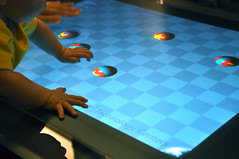 Gnomedex 9 ended several days ago, but I needed to think about it a bit before writing my overall impressions. Each year (I've been part of five Gnomedexes now) has a different vibe, and this one was a bit hard to pin down.
Gnomedex 9 ended several days ago, but I needed to think about it a bit before writing my overall impressions. Each year (I've been part of five Gnomedexes now) has a different vibe, and this one was a bit hard to pin down.
It was certainly less confrontational. For whatever reason, none of the previous web-heavy-hitter attendees—Dave Winer, Steve Gillmor, Sarah Lacy, Jason Calacanis, Mark Canter, Doug Kaye, Adam Curry, et. al.—was there this time, which made for less high-level arguing (or grandstanding). And while many of the sessions were fascinating, I didn't get my mind blown the way some of last year's talks did to me.
I think, perhaps, it was not quite as inspiring, but more fun. Notes and quotes:
- "Anybody still use Second Life? One person? How's it workin' for you?" - Chris Pirillo (At Gnomedex 6.0 in 2006, Second Life was the Current Big Thing. Not anymore.)
- "Sock Summit is Gnomedex for sock knitters. Thousands of women—and one guy —descended on Portland." - Beth Goza (Something I didn't know about knitters: they go on "yarn diets" to stop spending money on new yarn, i.e. fight the addiction.)
- "If anyone here is a mathematician, I made this up!" - Micah Baldwin
- "We're not geeks, but we're really really trying hard to be." - Leah Nelson
- In a brief appearance onstage, I mentioned a photo of the planet Mercury my dad took in 2006, and an Astronomy Picture of the Day of the International Space Station taken in a similar way.
- Mark Horvath said that, "The average homeless person is America is nine years old." But it didn't take long to find out that's not true. Regardless, the story of James (who isn't nine, and who came onstage too) was compelling, and we raised some money for him.
- The un-seeable space of the Internet makes us all astronaut-style cyborgs in its space, according to Amber Case. And these days, you break your cellphone and you say, "Crap, now I can't hear all the way to Egypt at the touch of a button anymore." Also, "People have enough trouble with driver's ed right now, so, uh, jetpacks?"
I was also glad to have a hug with Drew Olanoff, who was diagnosed with cancer only three months ago and has turned it into a worldwide fundraising effort already. I Blame Drew's Cancer that I didn't manage that when I found out about my cancer in 2007.
On our last night in Seattle, Air and I spent the dinner hour pounding open steamed crab legs with little wooden hammers, then had a drink and watched the Moon set behind a sailboat at our hotel. The next morning as we left the hotel driveway, we saw this:
I'd say it was worth going.
Labels: cancer, conferences, friends, geekery, gnomedex, seattle
21 August 2009
Gnomedex 2009 day 1
 My wife Air live blogged the first day's talks here at the 9th annual Gnomedex conference, and you can also watch the live video stream on the website. I posted a bunch of photos. Here are my written impressions.
My wife Air live blogged the first day's talks here at the 9th annual Gnomedex conference, and you can also watch the live video stream on the website. I posted a bunch of photos. Here are my written impressions.
Something feels a little looser, and perhaps a bit more relaxed, about this year's meeting. There's a big turnover in attendees: more new people than usual, more women, and a lot more locals from the Seattle area. More Windows laptops than before, interestingly, and more Nikon cameras with fewer Canons. A sign of tech gadget trends generally? I'm not sure.
As always, the individual presentations roamed all over the map, and some were better than others. For example, Bad Astronomer Dr. Phil Plait's talk about skepticism was fun, but also not anything new for those of us who read his blog. However, it was also great as a perfect precursor to Christine Peterson, who invented the term open source some years ago, but is now focused on life extension, i.e. using various dietary, technological, and other methods to improve health and significantly extend the human lifespan.
- Some stuff Dr. Plait said: "Skepticism is not cynicism." "You ask for the evidence [...] and make sure it's good." "Be willing to drop an idea if it's wrong. Yeah, that's tough." "Scientists screw it up as well." "It sucks to be fooled. You can lose your money. You can lose your life."
- Christine Peterson: "Moving is how you tell your body, I'm not dead yet!" "You see people hitting soccer balls with their heads. Would you do that with your laptop? And that's backed up!" (You might like my friend Bill's reaction on my Facebook page.)
As Lee LeFever quipped on Twitter, "The life extension talk is a great followup to the skepticism talk because it provides so many ideas of which to be skeptical." My thought was, her talk seemed like hard reductionist nerdery focused somewhere it may not apply very well. My perspective may be different because I have cancer; for me, life extension is just living, you know? But I also feel that not everything is an engineering problem.
There were a number of those dichotomies through the day. Some other notes I took today:
- Bre Pettis passed out 3D models "printouts" created with the MakerBot he helped design. "Bonus points for being able to print out your... uh... body... parts." "Oh my god, you should put this brain inside Walt Disney's head!" "What's black ABS plastic good for?" "Printing evil stuff."
- One of the most joyous things you'll ever see is a keen scientist really going off on his or her topic of specialty. Firas Khatib on FoldIt protein folding was one of those. For a given sequence of amino acids, the 3D protein structure with lowest free energy is likely to be its useful shape in biology—and his team made a video game to help people figure out optimum shapes, which in the long run can help cure diseases.
- Todd Friesen is a former search engine and website spammer. He had lots of interesting things today. In the world of white and black search engine optimization (SEO), SPAM = "Sites Positioned Above Mine." For spammers, RSS = "Really Simple Stealing" and thus spam blogs. Major techniques for web spammers: hacking pages, bribing people for access, forum posts and user profiles, comment spam. Pay Per Click = PPC = "Pills, Porn, and Casinos."
- I liked these from the Ignite super-fast presentations: "There are more social media non-gurus than social media gurus. Which means we can take them." On annual reports: "Imagine waiting A YEAR to find out what a company is doing."
We had a great trip down to Seattle via Chuckanut Drive with kk+ and Fierce Kitty. Tonight Air and I are sleeping in the Edgewater Hotel on Seattle's Pier 67, next to the conference venue, and tonight is also the 45th anniversary of the day the Beatles stayed in this same hotel and fished out the window.
Labels: anniversary, band, biology, conferences, geekery, gnomedex, history, music, science, travel
20 August 2009
Geek density maximum

We're off to Gnomedex, the fifth year Air and I will be participating. It has to be one of the densest collections of nerds around (as my panorama from last year shows)—sort of a web society annual family reunion. Including some of the emotional blow-ups that entails.
Watch for lots of photos from me and others, as well as some posts here.
Labels: conferences, friends, geekery, gnomedex, seattle, web
10 August 2009
More luscious black and white
It's partly because of the look of using a larger frame of film, partly the texture it imbues, and partly because I'm just more careful when using an expendable resource, but as I've mentioned before, I get more keeper photographs when I shoot with black and white film than when I use my digital SLR. These are from a couple of recent rolls:
I didn't have to go far to get them either—I took all these pictures either in our house, in the yard, or at my kids' school up the street, all with natural light and no flashes or reflectors. I'm certainly not regretting my purchase of that used Nikon F4 or macro lens last year.
Time to pick up another roll or two of B&W, I think. I've run out for now.
Labels: film, geekery, nikon, photography
26 July 2009
My new Crumpler man purse
On the way down to Workspace to visit the Blogathon crew yesterday, my daughters and I passed by the Crumpler store at the edge of Gastown in downtown Vancouver. After nearly losing my wallet on a chairlift in Whistler earlier in the month (I did drop a snack bar), I realized that my old Hedgren shoulder bag/man purse, at least five years old, needs replacing.
I've been searching for something that can hold all the stuff I haul with me (insulin, blood glucose meter, Leatherman tool, wallet, emergency sugar, mobile phone, etc.), plus my monster DSLR camera and whatever extras I might grab for a particular day. Something bigger than I had been carrying, in other words:
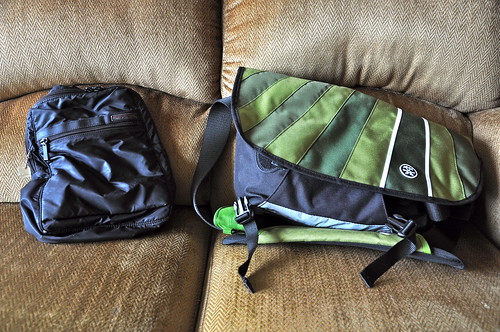
Old Hedgren bag on the left, new Crumpler bag on the right.
Since I sling my bag over my shoulder everywhere I go, I know what I need. I like my bags, and have blogged about them a couple of times before. But none of my current other bags would do the job. I had no luck finding a replacement along Vancouver's outdoor-gear row on Broadway near Cambie Street, but Crumpler had something I liked: the Barney Rustle Blanket shoulder bag.
Yes, Crumpler has pretty weird names for its products. Check out the names of the various bags John Biehler has bought over the years, for instance. You can pick up the Barney Rustle in green on Amazon for $125 USD, or some other colours for less, but even Crumpler's own site doesn't offer prices as good as the real-world store. I got my Barney Rustle for $89 Canadian, plus tax.
Yeah, it's a lot bigger than my old bag. I could stuff my SLR into the old bag, but it was then completely full, and prone to unzipping and falling open. The new one takes the camera with a big lens, plus my flash, with room to spare. I could drop a laptop inside if needed. The thing is built like a medieval fortress in nylon. I'm still figuring out just how I prefer to pack it, but I definitely like it so far.
Labels: bags, family, geekery, photography
14 July 2009
Links of interest 2006-07-05 to 2006-07-13
Yup, still on a blog break. So, more of my selected Twitter posts, newest first:
- Vancouver to Whistler in one minute (okay, I cheated):
- We're in the mountains, but in a civilized way. Pool/hot tub, grocery store across the street, Wi-Fi. But, uh, there is mountain weather.
- Super-duper stop-motion movie with 60,000 photo prints (ad for Olympus, via Lisa Bettany and Photojojo). Chris Atherton points out that this follows Wolf and Pig.
- Okay camera nerds, here's some rangefinder pr0n for you.
- The stereotypically blingtastic (and boobtastic) video diminishes Karl Wolf's tolerable version of Toto's "Africa." (And I'm no Toto fan.) It's like a live-action Hot Chicks with Douchebags. Yes, the choirboy harmonies are actually kind of charming, but he's going P-Diddy on it in the end.
- In the storage closet, my kids found something of mine from 1976 that is EVEN GEEKIER than my U.S.S. Enterprise belt buckle:

Red shirts were available back then, as well as the blue Mr. Spock style, but I chose Kirk. Of course. - The only sounds I can hear right now: the dishwasher, the fan in the hallway, and the birds in the trees outside the window.
- During my biology degree, Platyhelminthes was a favourite organism name. Now there's a plush toy! (With 2 heads!!)
- When I used to busk with the band, our biggest victories were scaring away the holy rollers across the street (we got applause).
- Neat. When a ship is built, here are the differences between milestones: keel laying, christening, commissioning, etc.
- AutoTune the News #6. Even more awesome.
- Picked up kids from Aldergrove camp. Sadly, there was a terrible accident on the Port Mann Bridge. We took a long Langley/Surrey/New Westminster detour.
- Google's changing culture. Point: Google now has more employees than Microsoft did at launch of Windows 95.
- Time lapse: 8 hours from my front window in about 1 min 30 sec, made with my new Nikon D90 and free Sofortbild capture software (and iMovie):
Something like John Biehler's Nikon Coolpix P6000 is better for timelapse long term; the D90's mechanical shutter, which is rated for 100,000 uses, would wear out in less than 6 months if used for time lapse every day. P.S. Andy Gagliano pointed to a useful Macworld podcast about making time-lapse movies. - Depressing: most Internet Explorer 6 users use it at work, because they're not allowed to use another browser.
- These Christopher Walken impressions are way funnier than I expected.
- The way monkeys peel a banana shows us we've all been doing it the needlessly hard way all these years.
- Um... hot!
- Most appropriate Flash cartoon ever?
- Drinking whisky and Diet Dr. Pepper, watching MythBusters. Pretty mellow.
- A good photo is "not about the details or the subject. It's what your subconscious pulls out of it all without thinking."
- Just picked up another month's supply of horrible, nasty, vile, wonderful, beautiful, lifesaving anti-cancer pills. Thanks, Big Pharma Man.
- My wife tells me she's discovered a sure-fire tip for a gal to attract quality guys in public: carry a huge SLR camera over your shoulder.
- "For the great majority [...] blogging is a social activity, not an aspiration to mass-media stardom."
- Just talked to younger daughter (9) for first time after three days at summer camp. She's a little homesick, but having fun.
- I took a flight over a remote landscape:
- The 50 worst cars of all time (e.g. "The Yugo had the distinct feeling of something assembled at gunpoint").
- I haven't seen either Transformers movie, but that's okay, I saw this.
- Dan Savage: cheating on your spouse should now be known as "hiking the Appalachian Trail." Good point in the article too.
- You can still buy a station wagon with fake wood paneling!
- Train vs. tornado. It does not end well. Watch without fast-forward/scrubbing for maximum tension.
- Just lucked into a parking spot on Granville Island. Time for some lunch.
- Sent the kids off for a week of horse-riding camp today. Wife Air and I had sparkling wine in the garden. Vewwy vewwy quiet around here.
- Just sorted a bunch of CDs. Still several discs missing cases, and cases missing discs. I feel like a total '90s throwback.
- Rules of photography (via Alastair Bird).
- When did the standard Booth Babe uniform become cropped T-shirt and too-short schoolgirl kilt?
- Listening to "Kind of Blue." It's been awhile.
- "A two-year old is kind of like having a blender, but you don't have a top for it." - Jerry Seinfeld (via Ryan).
Labels: audio, biology, blog, cancer, chemotherapy, family, flickr, geekery, google, microsoft, movie, music, oceans, photography, sex, startrek, transportation, video, whistler

